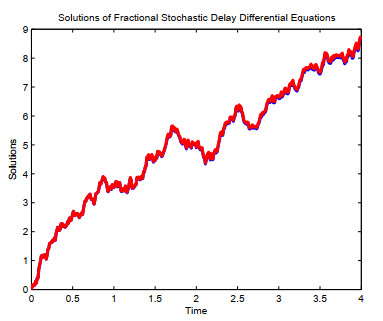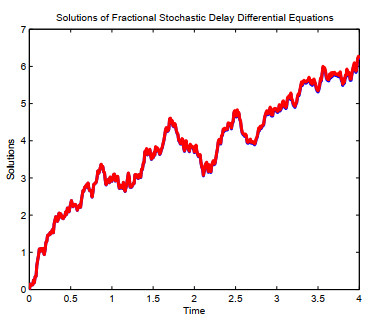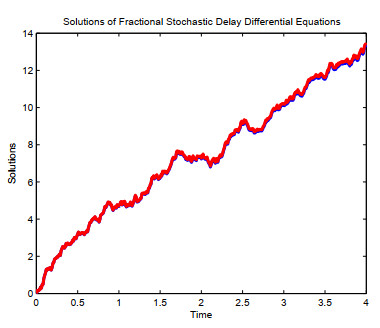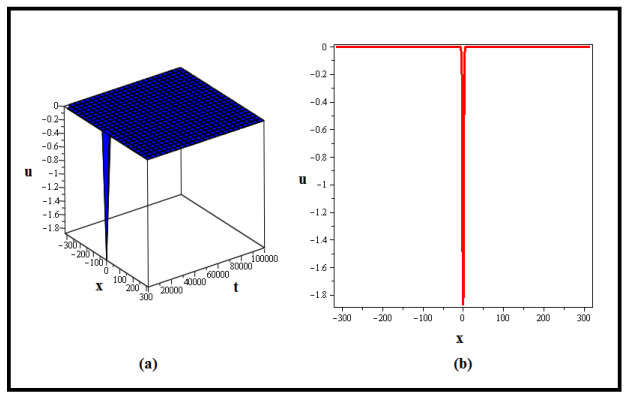1.
Introduction
Numerous fractional operators are discussed in the literature [1,2,3], with the Caputo and Riemann-Liouville derivatives being the most significant and widely used [4,5,6]. In 2000, Hilfer [7] generalized the Riemann-Liouville derivative, introducing what is now referred to as the Hilfer fractional derivative (HFrD).
In literature, various authors used HFrD in their research work with fractional differential and integro-differential models; for example, Raghavan et al. [8] found solutions of the fractional differential equations (FrDEs) with HFrD applying the Laplace transform. Li et al. [9] developed results on the existence and uniqueness and also developed solutions for FrDEs by HFrD. Zhu et al. [10] extracted the solutions of fractional integro-differential models with HFrD. Bedi et al. [11] developed results of the existence and uniqueness of solutions for Hilfer FrDEs. Kasinathan et al. [12] developed results related to mild solutions for FrDEs. Lv and Yang [13] established results for the existence and uniqueness of mild solutions for stochastic models applying semigroup theory. Jin et al. [14] researched the existence and uniqueness of mild solutions to the diffusion model. Karthikeyan et al. [15] discussed results about the controllability of delayed FrDEs. Hegade and Bhalekar [16] developed results of stability for FrDEs. For more studies related to work with HFrD, see [17,18].
In recent years, many scholars have actively worked on various topics related to different classes of fractional stochastic differential equations (FSDEs). In [19], Batiha et al. proposed an innovative approach for solving FSDEs. They obtained approximate solutions for these equations and compared the results with solutions obtained by other methods. Chen et al. [20] established the existence and uniqueness of solutions to FSDEs and presented results related to stability. The authors also found solutions using the Euler-Maruyama technique for FSDEs. Moualkia and Xu [21] undertook a theoretical analysis of variable-order FSDEs. They determined approximate solutions for these equations and assessed their accuracy by comparing them with solutions from alternative methods. In [22], Ali et al. investigated the coupled system of FSDEs regarding the existence and uniqueness of solutions and stability and found solutions. Li et al. carried out a stability investigation of a system of FSDEs in [23]. The research analyzes the interaction between fractional calculus, stochastic processes, and time delays to provide a better understanding of system stability. It sheds light on the effective solution of these equations via several numerical methods. Moreover, the paper examined various types of stability in FSDEs. Albalawi et al. [24] conducted existence and uniqueness of solution and stability analysis for FSDEs with conformable derivatives. In [25], Doan et al. established the convergence of the Euler-Maruyama approach for FSDEs, found solutions using this technique, and presented stability results. In [26], Umamaheswari et al. discussed the existence and uniqueness of solutions using the Picard scheme for FSDEs with Lévy noise. In [27], Li et al. studied Hilfer FSDEs with delay concerning the existence and uniqueness of solutions using the Picard method. Moreover, they investigated finite-time stability using various inequalities. For further information on FSDEs, refer to [28,29,30,31,32].
Stochastic fractional delay differential equations (SFDDEs) are a mathematical model that includes fractional derivatives to take into account memory effects, delays in the display of time layer interactions, and stochastic processes for recording randomness or noise. These equations are particularly suitable for systems where past conditions, delay effects, and random variations have a significant impact on dynamics. SFDDEs find applications in various real-life scenarios, such as modeling biological systems with delayed feedback and environmental noise (e.g., population dynamics), engineering systems with memory and delays (e.g., control systems in robotics), finance (e.g., asset pricing with time-lagged market responses), and physics (e.g., viscoelastic materials with delayed stress-strain relationships). By integrating these complex factors, SFDDEs provide a robust framework for analyzing and predicting the behavior of time-dependent, uncertain systems.
The average principle is a valuable way to analyze various systems. Focusing on averaged equations instead of the original complex time-dependent system provides an effective way to simplify the analysis and reduce complexity. The effectiveness of the average principle depends on the identification of conditions in which the system averaged in a particular context corresponds to the original system. Various authors have presented results on the average principle from different perspectives, such as Zou et al. [33], who established the average principle for FSDEs with impulses. Zou and Luo [34] established a novel result regarding the average principle for SFDDEs with the Caputo operator. The authors [35] established a result on the average principle with the Caputo derivative for neutral FSDEs. Mao et al. [36] established averaging principle results for stochastic delay differential equations with jumps. Xu et al. [37] also worked to prove an averaging principle theorem for FSDEs. Guo et al. [38] studied the averaging principle for stochastic differential equations under a general averaging condition, which is weaker than the traditional case. In [39,40], the authors proved the averaging principle for impulsive FSDEs. Ahmed and Zhu [41] presented results regarding the averaging principle for Hilfer FSDEs with Poisson jumps. Xu et al. [42] presented an averaging principle for Caputo FSDEs driven by Brownian motion in the mean square sense. Jing and Li [43] worked on the averaging principle for backward stochastic differential equations. Djaouti et al. [44] presented some generalizations of the averaging principle for neutral FSDEs. Mouy et al. [45] also proved the averaging principle for Caputo-Hadamard FSDEs with a pantograph term. Liu et al. [46] presented results for Caputo FSDEs with Brownian motion and Lévy noise [47]. Yang et al. [48] presented results for FSDEs with Poisson jumps regarding the averaging principle.
Motivated by the above discussion, this paper presents significant findings on the existence and uniqueness of solutions, continuous dependence (Con-D), regularity, and average principle for Hilfer SFDDEs of the pth moment. The pth moment is a crucial tool for studying stochastic systems, helping assess the system's behavior and stability by providing a measure of its response over time. The pth moment can be applied to study the behavior of a stochastic system by analyzing its expected value. Moreover, the pth moment is an essential tool in probability analysis, offering a convenient framework for investigating and verifying the stability of stochastic systems.
This research study uses the contraction mapping principle to determine the existence and uniqueness results of the Hilfer SFDDES solution. Next, we present the Con-D results by assuming that the coefficients correspond to the global Lipschitz condition. Additionally, various inequalities are used to describe regularity and determine average principle results. Finally, examples and graphic illustrations are included to support the results derived from this study.
Remark 1.1. By proving the outcomes of the theoretical analysis regarding well-posedness, regularity, and average principle, we conclude that these results can be generalized to SFDDEs with the Hadamard fractional operator.
Remark 1.2. Unlike traditional fractional models, SFDDEs with HFrD present a fundamental challenge due to the interaction of memory, randomness, and time delay effects. These complexities make it even more difficult to derive analytical or approximate solutions and ensure stability. Furthermore, the relationship between HFrD and probabilistic properties requires careful treatment of functional spaces, noise structures, and solution methods.
Listed below are the main contributions of our study:
(1) This research work establishes results on the well-posedness, regularity, and average principle for SFDDEs concerning HFrD.
(2) Most of the findings related to existence, uniqueness, and average principle for FSDEs have been established in the mean-square sense; however, we obtained these results using the pth moment. Consequently, our study extended the results on well-posedness and average principle for SFDDEs to the case where p=2.
(3) We provide several numerical examples along with their graphical representations to verify the accuracy and reliability of our theoretical findings.
(4) We provide results for FSDEs with a delay term.
In this research, we study the following SFDDEs driven by Brownian motions:
where s∈R+ is the delay time, σ(c) is the history function for all c∈[−s,0], and Dϑ,a0+ represents HFrD with orders 0≤ϑ≤1, 12<a<1. The f:[0,M]×Rm×Rm→Rm and g:[0,M]×Rm×Rm→Rm×b are the m-dimensional measurable functions. The stochastic process (wc)c∈[0,∞) follows a standard Brownian trajectory within the b-dimensional complete probability space (Ω,F,P). σ:[−s,0]→Rm is a continuous function. Assume that the norm of Rm is ‖⋅‖ and E‖σ(c)‖p<∞. The operator I(1−ϑ)(1−a)0+ is the Riemann-Liouville fractional integral operator.
The structure of the paper is as follows: The next section, Preliminary, discusses definitions, a lemma, and some assumptions. Section 3 presents the main results regarding Hilfer SFDDEs. Section 4 provides results related to average principle. Then, we present examples to illustrate our established theoretical results in Section 5. Section 6 contains the conclusion, and we discuss future directions.
2.
Preliminaries
First, we discuss the most important part of the paper, which serves as the foundation of our established results.
Definition 2.1. [49] Considering a function ϖ(c), the fractional integral operator of order a can be expressed as
Definition 2.2 [50] The HFrD of order 0≤ϑ≤1 and 0<a<1 is given as follows:
here, D=ddc.
Lemma 2.1. [50] When a>12 and c>0, we have
Definition 2.3. For p≥2 and c∈[0,∞), assume Apc=Lp(Ω,F,P) consists of all Fcth measurable with pth integrable ϖ=(ϖ1,ϖ2,⋯,ϖm)T:Ω→Rm as
The ϖ(c):[0,M]→Lp(Ω,F,P) is an F−adapted process when ϖ(c)∈Apc and c≥0. For σ′∈Ap0, the ϖ(c) is a solution of Eq (1.1) if
For f and g, assume the following:
● (H1) When ∀ℓ1,ℓ2,ζ1,ζ2∈Rm, there are U1 and U2 such as
● (H2) For f(c,0,0) and g(c,0,0), we have
Now, assume the following:
● (H3) When ∀ℓ1,ℓ2,ζ1,ζ2,ℓ,ζ∈Rm, c∈[0,M], there is U3>0 such as
● (H4) For f and g in system Eq (1.1), for ℓ,ζ∈Rm, and c∈[0,M], we can find a constant U4>0 such that it satisfies the following:
● (H5) There exist functions ˜f and ˜g, along with positive bounded functions ℵ1(M1) and ℵ2(M1) defined for M1∈[0,M], such that for all c∈[0,M], ℓ,ζ∈Rm, and p≥2, the following holds:
where limM1→∞ℵ1(M1)=0, limM1→∞ℵ2(M1)=0 and ℵ1(M1), ℵ2(M1) are positively bound functions.
3.
The main results
This section establishes the well-posedness and regularity of the solutions to SFDDEs.
3.1. Well-posedness
First, we present the important results regarding well-posedness for SFDDEs.
We have ℏσ:Hp(0,M)→Hp(0,M) with ℏσ(ϖ(0))=σ′. Then,
The main tool for establishing the key results is as follows:
Lemma 3.1. Assume that (H1) and (H2) hold; then ℏσ is well-defined.
Proof. For ϖ(c)∈Hp[0,M] and c∈[0,M], the following results are derived using Eqs (3.1) and (3.2):
By Hölder's inequality, we have
From (H1), we obtain
Accordingly, we obtain
By Eqs (3.4) and (3.6), we get the following:
By (H2), we obtain
By Burkholder-Davis-Gundy inequality and Hölder's inequality, we obtain
By utilizing (H1) and (H2), we obtain
So, we get
So, from above, we have
By using Eq (3.12) in Eq (3.9), we obtain
By putting Eqs (3.8) and (3.13) into Eq (3.3), we find that ‖ℏσ(ϖ(c))‖Hp<∞. So, the ℏσ is well-defined.
Now, we establish the result regarding existence and uniqueness.
Theorem 3.1. If (H1) and (H2) are satisfied, then Eq (1.1) with ϖ(0)=σ′ has a unique solution.
Proof. Taking η>0:
where
The weighted norm ‖⋅‖η is
For ϖ(c) and ˜ϖ(c), we obtain
Using the Hölder's inequality and (H1), we obtain
Hence, we have
However, using (H1) and the Burkholder-Davis-Gundy inequality, we have
So, from above
Thus, ∀c∈[0,M], we have
So,
Now, we use the following:
We obtain the required result from Eq (3.23).
From Eq (3.14), we obtain 2δΓ(2a−1)η<1.
Theorem 3.2. If ξa(c,σ) is a solution that is Con-D on a, then
Proof. Assume a, ˜a∈(12,1). Then,
We extract the subsequent outcome from Eq (3.26) by employing Eq (3.2).
Suppose the following:
By Hölder's inequality, (H1), (H2), and Eq (3.2), we have
Now, by Burkholder-Davis-Gundy inequality, Eq (3.28), (H1), and (H2), we obtain
Thus, we obtain the following:
From the above, we have
Now, we prove the following:
We possess the following:
It thereby demonstrated the necessary outcome.
Theorem 3.3. For \sigma, \Psi\in\mathbb{A}^{\mathrm{p}}_{0} , we have
Proof. As we have
By applying Eq (3.2), we obtain
By Hölder's inequality and (\mathbb{H}_{1}) , we obtain
Hence, we have
Now, utilizing (\mathbb{H}_{1}) , Hölder's inequality, and Burkholder–Davis–Gundy inequality, we derive
By substituting Eqs (3.37) and (3.39) into Eq (3.36), we obtain
By referring to the Grönwall inequality, we conclude
Thus, we obtain the following result:
Hence, we
The proof is so done.
3.2. Regularity
The following result pertains to regularity.
Theorem 3.4. If (\mathbb{H}_{1}) and (\mathbb{H}_{2}) are valid, then for \mathscr{S} > 0 , we have
Proof. For \mathfrak{c} > \varsigma , then from Eq (3.2):
By Hölder's inequality and Burkholder-Davis-Gundy inequality, we obtain
We have
And also
Furthermore,
So,
Hence,
where
Thus, we obtain the following:
4.
Averaging principle result
Now, we establish results concerning the average principle in the \mathrm{p} th moment for SFDDEs within the framework of the HFrD.
Lemma 4.1. For \widetilde{\mathfrak{g}} , when \mathbb{M}_{1}\in[0, \mathbb{M}] , we obtain
where \mathscr{U}_{6} = \left(2^{\mathrm{p}-1}\aleph_{2}\left(\mathbb{M}_{1}\right)+6^{\mathrm{p}-1}\mathscr{U}_{4}^{\mathrm{p}}\right) .
Proof. By \left(\mathbb{H}_{4}\right), \left(\mathbb{H}_{5}\right) , and Eq (3.2),
The following is a lemma regarding the time-scale property of the HFrD.
Lemma 4.2. Suppose the time scale \mathfrak{c} = \mu\gamma , then
Proof. The HFrD of order 0\leq\vartheta\leq1 and 0 < \mathfrak{a} < 1 is defined as
Let \mu\varphi = \mathscr{A} , and by the chain rule, \frac{\mathrm{d}}{\mathrm{d}\varphi} = \frac{\mathrm{d}}{\mathrm{d}\mathscr{A}}.\frac{\mathrm{d}\mathscr{A}}{\mathrm{d}\varphi} = \frac{\mathrm{d}}{\mathrm{d}\mathscr{A}}.\frac{\mathrm{d}}{\mathrm{d}\varphi}(\mu\varphi) = \mu\frac{\mathrm{d}}{\mathrm{d}\mathscr{A}} . So, we have
From the above, we have
likewise, we obtain
So, we have the following result:
Now, we establish an important result concerning average principle.
Suppose \frac{\mathfrak{c}}{\varepsilon} = \nu . By Lemma 4.2 and from Eq (4.1):
By considering \mathrm{d}\mathrm{w}{(\varepsilon\nu)} = \sqrt{\varepsilon}\mathrm{d}\mathrm{w}{(\nu)} and representing \varpi({\varepsilon\nu}) = \varpi_{\varepsilon}({\nu}) and \varpi(\varepsilon\nu-\varepsilon\mathrm{s}) = \varpi_{\varepsilon}(\nu-\mathrm{s}) , we get
Despite the loss of generality, \nu = \mathfrak{c} can be stated. The standard form of Eq (1.1) can be obtained by applying \frac{\mathfrak{c}}{\varepsilon} \rightarrow \mathfrak{c} .
Thus, Eq (4.2) can be expressed integrally as
for \varepsilon\in(0, \varepsilon_{0}] . The average of Eq (3.35) is as
where \widetilde{\mathfrak{f}}:\mathbb{R}^{\mathfrak{m}}\times\mathbb{R}^{\mathfrak{m}}\rightarrow \mathbb{R}^{\mathfrak{m}}, \widetilde{\mathfrak{g}}:\mathbb{R}^{\mathfrak{m}}\times\mathbb{R}^{\mathfrak{m}}\rightarrow \mathbb{R}^{\varkappa\times\mathfrak{b}} .
Theorem 4.1. When \mho > 0 and \varrho > 0 , and \varepsilon_{1} \in \left(0, \varepsilon_{0}\right] with \kappa \in \left(0, \mathfrak{a}\mathrm{p} - \frac{\mathrm{p}}{2}\right) , then
Proof. By Eqs (3.35) and (4.4), for \mathfrak{c} \in [0, \mathfrak{u}] \subseteq [0, \mathbb{M}] , we have
Via Jensen's inequality, we have
Utilizing Eq (4.7) in Eq (4.5),
From \mathscr{Q}_{1} , we have
By Hölder's inequality, Jensen's inequality, and (\mathbb{H}_{3}) applied to \mathscr{Q}_{11} :
here, \mathscr{Q}_{11} = \bigg(\frac{\mathrm{p}-1}{(\mathfrak{a}\mathrm{p}-1)}\bigg)^{\mathrm{p}-1}\big(\frac{1}{\Gamma(\mathfrak{a})}\big)^{\mathrm{p}} 2^{3\mathrm{p}-3}\mathscr{U}_{3}^{\mathrm{p}} .
By Hölder's inequality, Jensen's inequality, and (\mathbb{H}_{5}) on \mathscr{Q}_{12} ,
where \mathscr{Q}_{12} = \big(\frac{1}{\Gamma(\mathfrak{a})}\big)^{\mathrm{p}} 2^{2\mathrm{p}-2} \big(\frac{\mathrm{p}-1}{(\mathfrak{a}\mathrm{p}-1)}\big)^{\mathrm{p}-1} \aleph_{1}(\mathfrak{u}) \big(1+\mathrm{E}\big\Vert \varpi_{\varepsilon}^{*}(\varphi)\big\Vert^{\mathrm{p}}+ \mathrm{E}\big\Vert\varpi_{\varepsilon}^{*}(\varphi-\mathrm{s})\big\Vert^{\mathrm{p}}\big) .
The following is provided by \mathscr{Q}_{2} via Jensen's inequality:
By applying (\mathbb{H}_{3}) , Hölder's inequality, and Burkholder-Davis-Gundy inequality on \mathscr{Q}_{21} ,
where \mathscr{Q}_{21} = 2^{3\mathrm{p}-3}\mathscr{U}_{3}^{\mathrm{p}} \left(\frac{\mathrm{p}^{\mathrm{p}+1}}{2(\mathrm{p}-1)^{\mathrm{p}-1}}\right)^{\frac{\mathrm{p}}{2}} \big(\frac{1}{\Gamma(\mathfrak{a})}\big)^{\mathrm{p}} .
By Hölder's inequality and Burkholder-Davis-Gundy inequality,
where
Using Eqs (4.9) to (4.14) in (4.8),
From Eq (4.15),
So, for \varrho > 0 and \kappa\in(0, \mathfrak{a}\mathrm{p}-\frac{\mathrm{p}}{2}) with \mathfrak{c}\in\left[-\mathrm{s}, \varrho\varepsilon^{-\kappa}\right]\subseteq[0, \mathbb{M}] , we obtain
where
So, proved the required result.
5.
Examples
To better understand the theoretical results established in this research, we present examples along with graphical comparisons of the original and averaged solutions. Figures 1–4 illustrate these comparisons, supporting the validity of our theoretical findings.
Example 1. Consider the following:
where \mathfrak{a} = 0.95 , \mathrm{s} = \frac{1}{2} , and
The criteria of existence and uniqueness are fulfilled by \mathfrak{f}(\mathfrak{c}, \varpi(\mathfrak{c}), \varpi(\mathfrak{c}-\mathrm{s})) and \mathfrak{g}(\mathfrak{c}, \varpi(\mathfrak{c}), \varpi(\mathfrak{c}-\mathrm{s})) .
The averages of \mathfrak{f} and \mathfrak{g} are as
The corresponding average is
All conditions in Theorem 4.1 are satisfied by system (5.1). As a result, solutions \varpi_{\varepsilon}(\mathfrak{c}) and \varpi^{*}_{\varepsilon}(\mathfrak{c}) are equivalent at the \mathrm{p} th moment in the limit as \varepsilon\rightarrow0 . Figure 1 presents a graphical comparison between solutions of the original system (5.1) and averaged system (5.2), demonstrating a strong agreement between solutions \varpi_{\varepsilon}(\mathfrak{c}) and \varpi^{*}_{\varepsilon}(\mathfrak{c}) and confirming the accuracy of our theoretical conclusions.
Example 2. Take the following:
where \mathfrak{a} = 0.90 , \mathrm{s} = \frac{1}{3} , and
The criteria of existence and uniqueness are fulfilled by \mathfrak{f}(\mathfrak{c}, \varpi(\mathfrak{c}), \varpi(\mathfrak{c}-\mathrm{s})) and \mathfrak{g}(\mathfrak{c}, \varpi(\mathfrak{c}), \varpi(\mathfrak{c}-\mathrm{s})) .
The averages of \mathfrak{f} and \mathfrak{g} are as
The corresponding average is
All requirements in Theorem 4.1 are fulfilled by Example 2. Consequently, solutions \varpi_{\varepsilon}(\mathfrak{c}) and \varpi^{*}_{\varepsilon}(\mathfrak{c}) are equivalent at the \mathrm{p} th moment in the limit as \varepsilon\rightarrow0 . Figure 2 provides a graphical comparison between solutions of the original system (5.3) and the averaged system (5.4), illustrating a strong agreement between \varpi_{\varepsilon}(\mathfrak{c}) and \varpi^{*}_{\varepsilon}(\mathfrak{c}) and validating the accuracy of our theoretical findings.
Example 3. Examine the following:
where \mathfrak{a} = 0.95 , \mathrm{s} = \frac{1}{4} , and
\mathfrak{f}(\mathfrak{c}, \varpi(\mathfrak{c}), \varpi(\mathfrak{c}-\mathrm{s})) and \mathfrak{g}(\mathfrak{c}, \varpi(\mathfrak{c}), \varpi(\mathfrak{c}-\mathrm{s})) satisfy the needs of existence and uniqueness.
The following are the averages:
Thus,
All conditions stated in Theorem 4.1 are satisfied by Example 3. As a result, solutions \varpi_{\varepsilon}(\mathfrak{c}) and \varpi^{*}_{\varepsilon}(\mathfrak{c}) are equivalent at the \mathrm{p} th moment in the limit as \varepsilon\rightarrow0 . Figure 3 depicts a graphical comparison between solutions of the original system (5.5) and the averaged system (5.6), demonstrating a strong agreement between \varpi_{\varepsilon}(\mathfrak{c}) and \varpi^{*}_{\varepsilon}(\mathfrak{c}) and confirming the accuracy of our theoretical results.
Example 4. Take the following:
where \mathfrak{a} = 0.95 , \mathrm{s} = \frac{2}{3} , and
The \frac{9}{2}\sin\big(\varpi_{\varepsilon}(\mathfrak{c})\big) \cos\big(\varpi_{\varepsilon}(\mathfrak{c})\big)\exp^{-\mathfrak{c}} and \sin\big(\varpi_{\varepsilon}(\mathfrak{c})\big) \varpi_{\varepsilon}(\mathfrak{c}-\frac{2}{3})\cos\big(\varpi_{\varepsilon}(\mathfrak{c})\big) satisfy the conditions of existence and uniqueness.
The averages of \mathfrak{f} and \mathfrak{g} :
So, we get
Figure 4 presents the same results as in Examples 1–3.
6.
Conclusions
Our research work is important as follows: First, by proving results of existence and uniqueness, Con-D, regularity, and average principle in the \mathrm{p} th moment, we extend the outcomes for \mathrm{p} = 2 . Secondly, for the first time in the literature, we construct well-posedness and average principle results in the context of HFrD of SFDDEs. Third, we consider SFDDEs, which represent a more generalized class of FSDEs, and we present some graphical results to prove the validity of our results.
The following are the main points we can work on in the future: We can explore the important concept of controllability for SFDDEs concerning HFrD. We can establish well-posedness, regularity, and average principle results for stochastic Volterra-Fredholm integral equations.
Author contributions
W. Albalawi, M. I. Liaqat, F. U. Din, K. S. Nisar and A. H. Abdel-Aty: Conceptualization, Methodology, Software, Validation, Formal analysis, Investigation, Writing–original draft preparation, Writing–review and editing, Visualization, Resources, Funding acquisition. All authors have read and approved the final version of the manuscript for publication.
Use of Generative-AI tools declaration
The authors declare they have not used Artificial Intelligence (AI) tools in the creation of this article.
Acknowledgments
The research work was supported by Princess Nourah bint Abdulrahman University Researchers Supporting Project number (PNURSP2025R157), Princess Nourah bint Abdulrahman University, Riyadh, Saudi Arabia. The authors are thankful to the Deanship of Graduate Studies and Scientific Research at University of Bisha for supporting this work through the Fast-Track Research Support Program.
Conflict of interest
The authors declare no conflicts of interest.
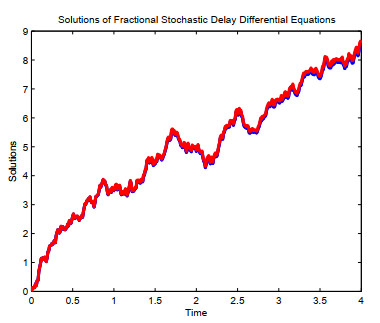









 DownLoad:
DownLoad:
